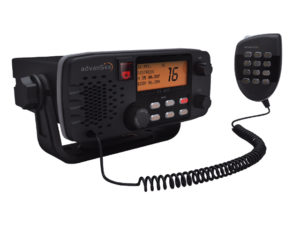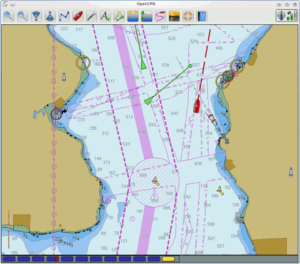A lot of people are wondering what we have done about the safety on the boat. Travelling by boat may sound dangerous for those who have never sailed. So we think it is important to understand what we have done about safety on Hoppetossa.
The boat
Hoppetossa is a safe ship. She has a, so called, center cockpit. This means that it is located closer to the middle of the ship and higher from the water. This gives a very safe feeling and prevent waves from rolling in. On deck are a lot of handles to grab and we have a line from the cockpit to the front to which we can connect our harnesses when we go out on deck. We have equipped the boat with a bathing platform with a deep ladder so we can get easily on board from the water. Inside we can hold on to a lot of handles when the sea makes us unstable. The kitchen is small so we can lean against the wall while we are cooking. All the cabins have fire distinguishers which are located close to the exits.
Communications
We have a VHF with DSC functionality. That means that we can press a button on the VHF and all the VHF’s in the neighborhood will give an alarm. Also when another boat is  pressing this button on his VHF the alarm o our VHF ring. We think about buying a radio transmitter but we think we will find a better deal on our way. As long as we are in Europe we don’t feel the need for a radio.
pressing this button on his VHF the alarm o our VHF ring. We think about buying a radio transmitter but we think we will find a better deal on our way. As long as we are in Europe we don’t feel the need for a radio.
Visibility
A big safety is visibility. Of course we have navigation lights to show ourselves in the dark. We als o have a so called radar reflector to make ourselves more visible to other radar screens. And with our own radar we can see ships and other objects when the visibility is not so good (fog, rain). We have invested in AIS (Automatic ident cation system). With this system we can see the ships around us on our navigation screen but we are also sending our data which means that other ships can see us on their navigation screens. And the systems are so smart. When they calculate that a ship is on collision course the systems go bananas, an alarm will sound and show the ship that are on collision course. We can then make contact to see what action must be taken.
o have a so called radar reflector to make ourselves more visible to other radar screens. And with our own radar we can see ships and other objects when the visibility is not so good (fog, rain). We have invested in AIS (Automatic ident cation system). With this system we can see the ships around us on our navigation screen but we are also sending our data which means that other ships can see us on their navigation screens. And the systems are so smart. When they calculate that a ship is on collision course the systems go bananas, an alarm will sound and show the ship that are on collision course. We can then make contact to see what action must be taken.
Personal safety
An old saying from me was ‘ones fallen off the ship, you are dead’. But with the new developments that is not the case anymore. We have bought 2 Ocean Signal RescueMe MOB1 AIS/DSC Beacon’s. This device you wear on your person and as soon as  you fall in the water it sends a distress signal which will make the alarm go on the VHF scream on all the boats in the neighborhood. Meanwhile it sends an AIS signal which will appe ar on the navigation screen so we’ll always know the exact coordinates of the person in the water. For all the people on the boat we have an (self-inflatable) life vest with an integrated harness. We also have a lifesling, so if somebody is too weak to come on board they can be winched on the boat.
you fall in the water it sends a distress signal which will make the alarm go on the VHF scream on all the boats in the neighborhood. Meanwhile it sends an AIS signal which will appe ar on the navigation screen so we’ll always know the exact coordinates of the person in the water. For all the people on the boat we have an (self-inflatable) life vest with an integrated harness. We also have a lifesling, so if somebody is too weak to come on board they can be winched on the boat.
Distress
When the shit really hits the fan (sinking or uncontrollable fire) we have more safety equipment. Of c ourse we have flares to get attention to the boat. But we also have a self-inflatable life raft with us. We choose a life raft which can be easily boarded and has a good reputation. In the life raft are some things that are necessary for the first need. Besides that we have a so called ‘grab bag’ in which there is more food, first aid kit and water. We also have an Ocean Signal RescueMe PLB1 with GPS PLB.
ourse we have flares to get attention to the boat. But we also have a self-inflatable life raft with us. We choose a life raft which can be easily boarded and has a good reputation. In the life raft are some things that are necessary for the first need. Besides that we have a so called ‘grab bag’ in which there is more food, first aid kit and water. We also have an Ocean Signal RescueMe PLB1 with GPS PLB.  This device (instead of an Epirb) is very small and can be carried on the person. It sends a signal to the nearest satellite with a distress call and the position. So this device works everywhere on the world (middle of the ocean, in the rainforest). Because it’s so small we can also take it with us on travels on land (like a hike in the desert).
This device (instead of an Epirb) is very small and can be carried on the person. It sends a signal to the nearest satellite with a distress call and the position. So this device works everywhere on the world (middle of the ocean, in the rainforest). Because it’s so small we can also take it with us on travels on land (like a hike in the desert).
